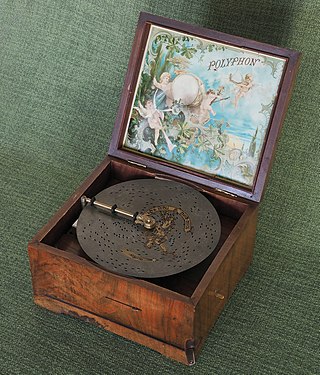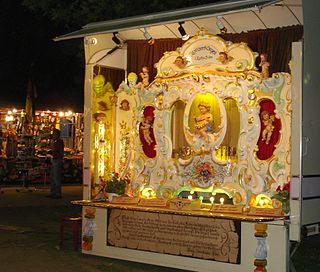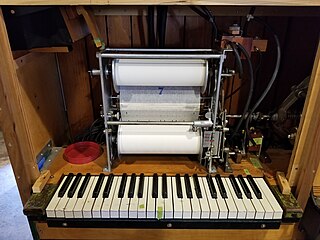
A player piano is a self-playing piano with a pneumatic or electromechanical mechanism that operates the piano action using perforated paper or metallic rolls. Modern versions use MIDI. The player piano gained popularity as mass-produced home pianos increased in the late 19th and early 20th centuries. Sales peaked in 1924 and subsequently declined with improvements in electrical phonograph recordings in the mid-1920s. The advent of electrical amplification in home music reproduction, brought by radios, contributed to a decline in popularity, and the stock market crash of 1929 virtually wiped out production.

A free reed aerophone is a musical instrument that produces sound as air flows past a vibrating reed in a frame. Air pressure is typically generated by breath or with a bellows. In the Hornbostel–Sachs system, it is number: 412.13. Free reed instruments are contrasted with non-free or enclosed reed instruments, where the timbre is fully or partially dependent on the shape of the instrument body, Hornbostel–Sachs number: 42.

A piano roll is a music storage medium used to operate a player piano, piano player or reproducing piano. Piano rolls, like other music rolls, are continuous rolls of paper with holes punched into them. These perforations represent note control data. The roll moves over a reading system known as a tracker bar; the playing cycle for each musical note is triggered when a perforation crosses the bar.

The Panharmonicon was a musical instrument invented in 1805 by Johann Nepomuk Mälzel, a contemporary and friend of Beethoven. Beethoven composed his piece "Wellington's Victory" to be played on Mälzel's mechanical orchestral organ and also to commemorate Arthur Wellesley's victory over the French at the Battle of Vitoria in 1813. It was one of the first automatic playing machines, similar to the later Orchestrion.

A music box or musical box is an automatic musical instrument in a box that produces musical notes by using a set of pins placed on a revolving cylinder or disc to pluck the tuned teeth of a steel comb. The popular device best known today as a "music box" developed from musical snuff boxes of the 18th century and were originally called carillons à musique. Some of the more complex boxes also contain a tiny drum and/or bells in addition to the metal comb.

A barrel organ is a French mechanical musical instrument consisting of bellows and one or more ranks of pipes housed in a case, usually of wood, and often highly decorated. The basic principle is the same as a traditional pipe organ, but rather than being played by an organist, the barrel organ is activated either by a person turning a crank, or by clockwork driven by weights or springs. The pieces of music are encoded onto wooden barrels, which are analogous to the keyboard of the traditional pipe organ. A person who plays a barrel organ is known as an organ grinder.

M. Welte & Sons, Freiburg and New York was a manufacturer of orchestrions, organs and reproducing pianos, established in Vöhrenbach by Michael Welte (1807–1880) in 1832.

A fairground organ is a musical organ covering the wind and percussive sections of an orchestra. Originated in Paris, France, it was designed for use in commercial fairground settings to provide loud music to accompany rides and attractions, mostly merry-go-rounds. Unlike organs for indoor use, they are designed to produce a large volume of sound to be heard above the noises of crowds and fairground machinery.

A street organ played by an organ grinder is a French automatic mechanical pneumatic organ designed to be mobile enough to play its music in the street. The two most commonly seen types are the smaller German and the larger Dutch street organ.

A music roll is a storage medium used to operate a mechanical musical instrument. They are used for the player piano, mechanical organ, electronic carillon and various types of orchestrion. The vast majority of music rolls are made of paper. Other materials that have been utilized include thin card (Imhof-system), thin sheet brass (Telektra-system), composite multi-layered electro-conductive aluminium and paper roll (Triste-system) and, in the modern era, thin plastic or PET film.

A mechanical organ is an organ that is self-playing, rather than played by a musician. For example, the barrel organ is activated either by a person turning a crank, or by clockwork driven by weights or springs.
Gavioli & Cie were a Franco–Italian organ builder company that manufactured fairground organs in both Italy and later France.

The photoplayer is an automatic mechanical orchestra used by movie theatres to produce photoplay music to accompany silent films.
The Automatic Musical Instruments Collectors' Association (AMICA) was formed in 1963 by a group of collectors in the San Francisco area, committed to the preservation, restoration and enjoyment of vintage mechanical musical instruments that play by themselves, focusing on those made from 1885–1935. Typical examples include player pianos, reproducing pianos, player reed organs, player pipe organs, orchestrions, music boxes, fairground organs, etc. Music media includes paper music rolls, folding continuous cardboard music, pinned cylinders, and pinned discs, etc. The scope of interest embraces not only the instruments themselves, but also their music media and published literature of the whole of the industry throughout this era.

The componium is a mechanical musical instrument constructed in 1821 by Dietrich Nikolaus Winkel that composes novel music. It is an automatic organ consisting of two barrels that revolve simultaneously. The barrels take turns performing two measures of randomly chosen music while the other, silent, slides horizontally to select the next variation. A roulette-like flywheel chooses whether or not the next variation is selected. The instrument plays an 80 measure piece, with eight variations for every two measures.
The Apollonicon was a self-acting barrel organ, built by the English Organ builders Flight & Robson in London and presented to the public the first time in 1817. Said to have been the biggest barrel and finger organ ever built, it was an automatic playing machine with about 1,900 pipes and 45 organ stops. It was inspired by Johann Nepomuk Mälzel's Panharmonikon. It also had five keyboards, one of them used as the pedal keyboard, so the instrument could be played by a few persons in manual mode as well.

Orchestrion is a studio album by jazz guitarist Pat Metheny that was released by Nonesuch Records on January 26, 2010.

The American Treasure Tour Museum is a tourist attraction established in 2010 and opened to the public for guided tours. Visitors travel through a large private collection that encompasses an eclectic variety of smaller collections. Included is one of the world's largest private collections of automatic music machines: nickelodeons, band organs, calliopes, photoplayers, and music boxes. There are also classic cars, circus art, dolls and dollhouses, and a large assortment of popular culture miscellanea. It is located in the 422 Business Center in the community of Oaks, Pennsylvania, west of Valley Forge National Historical Park just off of U.S. Route 422.

George William Henry Faulkes (1863–1933) – known professionally as William Faulkes – was an English musician now best known as the composer of organ music.
Traditional French musical instruments, known as instruments traditionnels in French, are musical instruments used in the traditional folk music of France. They comprise a range of string, wind, and percussion instruments.



















